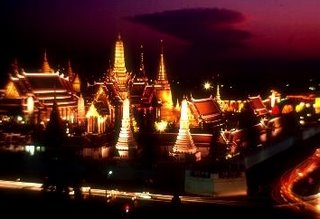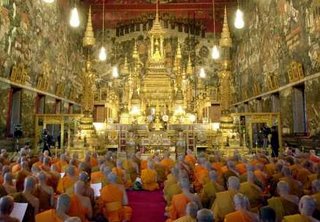Wat Pho - Temple of the Reclining Buddha in Bangkok
 Wat Pho or with it's full name Wat Phrachetuphon Wimon Mangkhalaram Raja Wora Mahavihara is Bangkok's largest temple. A giant reclining Buddha, 45 meters long represents the moment in which Buddha enters Nirvana. The size of this Buddha can only be experienced by walking around it. The feet of the statue feature 108 small images of representing Buddhist impressions. It is the enormous head of the Buddha which I like most.
Wat Pho or with it's full name Wat Phrachetuphon Wimon Mangkhalaram Raja Wora Mahavihara is Bangkok's largest temple. A giant reclining Buddha, 45 meters long represents the moment in which Buddha enters Nirvana. The size of this Buddha can only be experienced by walking around it. The feet of the statue feature 108 small images of representing Buddhist impressions. It is the enormous head of the Buddha which I like most.Wat Pho is also famous as Thailand's first university, and is center for traditional Thai masage - the rich, famous and powerful have all been known to come here. Inscribed on stone in the walls of Wat Pho are all that was known about Thai massage dating from the reign of King Rama III (most previous texts were lost when the Burmese destroyed Ayuthaya)
Wat Pho is an important Bangkok's landmark in the Rattanakosin Area. Visitors can enjoy the beautiful Buddhist fine arts and the existing Thai intellect which has descended from ancient times, taken as an immortal carrier's of knowledge. The monastery is opened daily from 08:00 to 17:00, with the admission fee of 20 baht.



















 Giant Guardian of Wat Phra Kaew in
Giant Guardian of Wat Phra Kaew in  The ubosot (ordination hall) housing the Emerald Buddha is actually the only original building in the Wat Phra Kaew. It was built at the same time as the temple in 1783 to 1785. Like most of the buildings in the compound, the ubosot's exterior is finished in colored mirror tiles and gilt carving. The eaves are lined with bronze bells which tinkle is the slightest breeze.
The ubosot (ordination hall) housing the Emerald Buddha is actually the only original building in the Wat Phra Kaew. It was built at the same time as the temple in 1783 to 1785. Like most of the buildings in the compound, the ubosot's exterior is finished in colored mirror tiles and gilt carving. The eaves are lined with bronze bells which tinkle is the slightest breeze. Mural painting inside the ubosoth in Wat Phra Kaew. The scene of the Buddhist cosmology (the Three `Worlds of Desire, Form and Non-Form) on the western wall behind the Emerald Buddha and that of the Enlightenment of the Buddha on the eastern, or front wall, were painted in the reign of' King Rama 1. At that time there probably was portrayed on the tipper part of the lateral walls the assembly of celestial beings who came to worship the main Buddha image in the ubosoth, a feature typical of the late Ayudhya and early
Mural painting inside the ubosoth in Wat Phra Kaew. The scene of the Buddhist cosmology (the Three `Worlds of Desire, Form and Non-Form) on the western wall behind the Emerald Buddha and that of the Enlightenment of the Buddha on the eastern, or front wall, were painted in the reign of' King Rama 1. At that time there probably was portrayed on the tipper part of the lateral walls the assembly of celestial beings who came to worship the main Buddha image in the ubosoth, a feature typical of the late Ayudhya and early  The mural painting inside were newly painted as mentioned above except for the scenes of the Buddhist cosmology and the Enlightenment of the Buddha, respectively, on the western and eastern walls. The golden throne of the Emerald Buddha in
The mural painting inside were newly painted as mentioned above except for the scenes of the Buddhist cosmology and the Enlightenment of the Buddha, respectively, on the western and eastern walls. The golden throne of the Emerald Buddha in